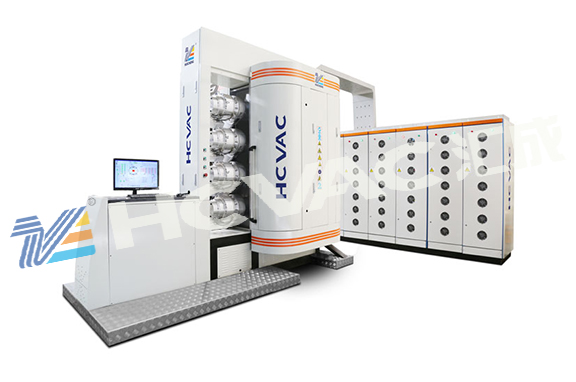The most commonly used coating processes of metal parts pvd coating machines are ion plating technology and magnetron sputtering coating technology. The following is an introduction to the operation process of multi-arc ion plating technology. I hope it can help everyone:

1. Metal parts decorative film plating process
The more mature coating technologies include arc ion plating, magnetron sputtering ion plating and composite ion plating. The following is a representative and typical plating process selected from various types of coating technologies for introduction. Use arc ion plating method to plate brass electroplating bright chromium or nickel watch case with ticn film.
Using small arc source coating machine and pulse bias power supply;
(1) Workpieces are cleaned, put on shelves, and put into the furnace
The workpiece must go through three processes of ultrasonic cleaning, pickling and rinsing before entering the furnace.
First, put the metal cleaning agent prepared according to the usage requirements into the ultrasonic cleaning tank, and use ultrasonic waves for degreasing and cleaning. After cleaning, pickling is performed, which can neutralize the residual alkali solution during ultrasonic cleaning and also act as an activation treatment. Then rinse to completely remove the acid. Deionized purified water or distilled water must be used during rinsing. After three washes, drying is carried out immediately. The temperature is generally controlled at about 100°C and the time is about 1 hour. You can also air-dry it and put it on the stove immediately.
(2) Preparation work before coating
①Clean the vacuum coating chamber. Clean the vacuum coating chamber with a vacuum cleaner. After multiple coatings, the inner lining of the vacuum coating chamber needs to be cleaned regularly, usually once every half a month.
② Check the arc evaporation source. Before starting work, make sure that the arc evaporation source is correctly installed, well insulated, and that the arc ignition needle can be controlled flexibly and has a suitable stroke that can just touch the cathode surface.
③ Check the insulation condition of the workpiece holder. The insulation between the workpiece holder and the ground must be good, and the contact points between the negative bias power supply and the workpiece holder must be in good contact.
After ensuring that there are no problems with the above mentioned tasks, you can close the door of the vacuum coating chamber and perform air extraction and coating.
(3) Vacuuming
Vacuum to 6.6 x 10-3pa. It starts with rough pumping, pumping from the atmosphere to about 5pa, and then uses an oil diffusion pump for fine pumping. During rough smoking, it can be baked and heated to 150°C. As the temperature of the coating chamber increases, the wall deflation will reduce the vacuum degree, and then rise again. Coating work can only be carried out when the temperature rises to 6.6 x 10-3pa.
(4) Bombardment cleaning
①Argon ion bombardment cleaning
Vacuum degree: The vacuum degree of high-purity argon (99.999%) is maintained at 2~3pa. Bombardment voltage: 800~1000v. Bombardment time: 10min.
At this moment, a glow discharge occurs in the vacuum coating chamber. The argon ions generated by the discharge hit the workpiece surface with high energy, sputtering the gases, impurities and atoms on the surface of the workpiece adsorbed on the surface, exposing the fresh surface of the material.
②Titanium bombardment
Vacuum degree: high-purity argon gas is supplied to maintain the vacuum degree at 2 x 10-2pa. Pulse bias voltage: 400~500v, duty cycle 20%. Arc current: 60~80a, arc evaporation sources are ignited alternately, and each arc evaporation source is ignited for 1~2 minutes.
(5)Coating
①Titanium plating
Vacuum degree: High-purity argon gas is supplied, and the vacuum degree is maintained at 2 x 10-2pa. Pulse bias voltage: 200~300v, duty cycle 50%. Arc current: 60~80a, ignite all arc sources, time 2~3min.
②Plating ticn
Vacuum degree: Pour in high-purity nitrogen to maintain the vacuum degree at (3~8) Variety. Controlling the ratio of n2 and c2h2 gases can achieve a predetermined color.
Arc current: 50~70a. Pulse bias voltage: 100~150v, duty cycle 60%~80%. Deposition temperature: around 200℃. Coating time: 10~20min, film thickness 0.2~0.5μm.
(6) Cooling
After the coating process is completed, first turn off the arc power supply and bias power supply, then turn off the air source and stop the rotating frame. When the workpiece is cooled to 80 to 100°C in the vacuum coating chamber, the coating chamber is filled with air and the workpiece is taken out.
The above is the general process of multi-arc ion
pvd coating machine coating process, which is widely used and the most common.



